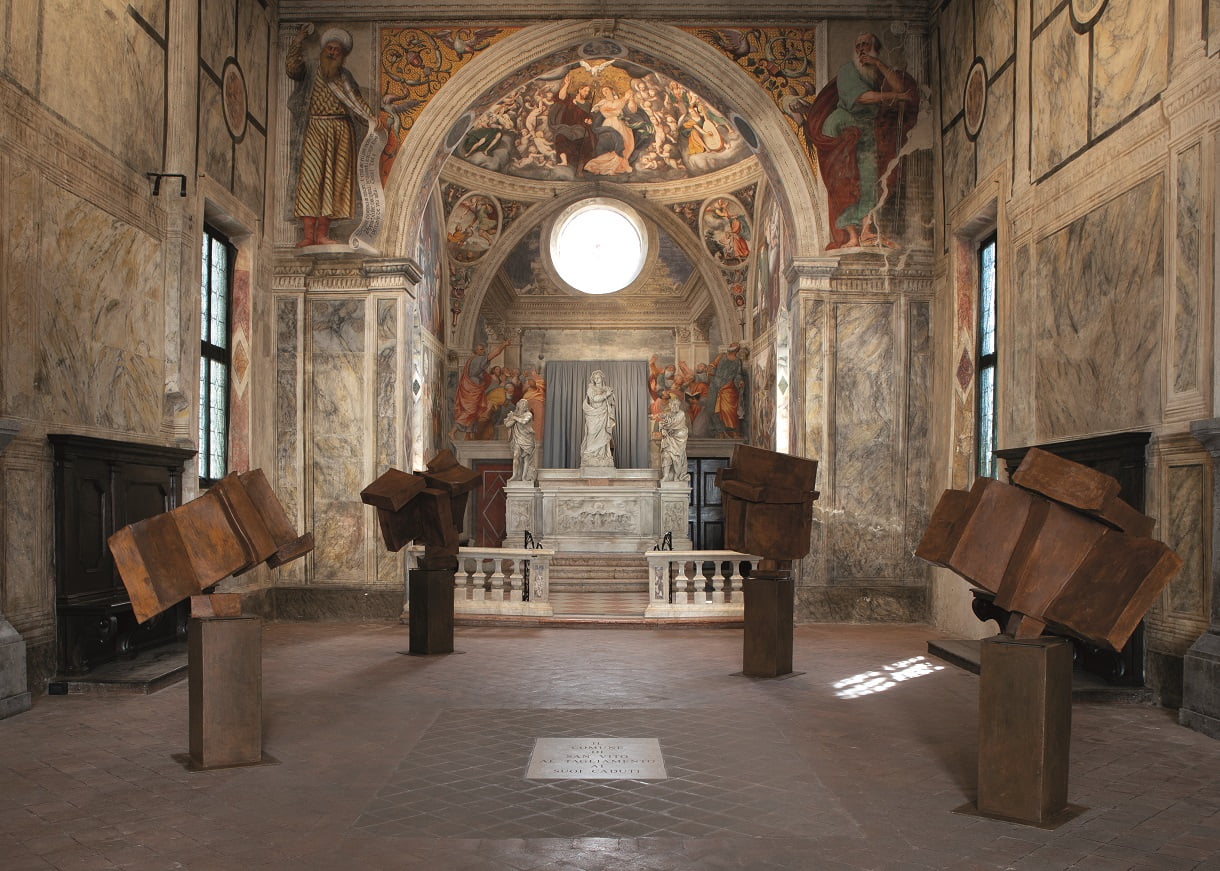Claudio Borghi’s artistic research is presented in this exhibition with a unified sculptural group, composed of four individual structures which can be read as a single work and, depending on the position in the space, can be seen as an environmental installation of autonomous works or a homogenous whole. This is a typical trait of the artist from Brianza: as an abstract sculptor, he follows the artistic tradition of the Lombardy region, which for years has reflected on basic shapes, with an architectural vocation, without abandoning the relationship between the surrounding space and nature that is often evoked rather than represented.
The work displayed here has a double title: Hazness (frontone). Hazness consists of a recurring term in Borghi’s works and writings. It comes from a play on words originating with the term “senza nome” (which can be translated as ‘untitled’), widely used by contemporary artists. The word “senza” (‘without’) is often altered in different ways by Borghi, written backwards or by adding different letters such as the “h”, thus creating a linguistic and communicative ambiguity. For example, the meaning of the English term haziness, which can be translated in Italian as nebulosità, has a very important meaning for Borghi’s artistic production, and it gives us an idea of the importance that the sculptor places on the titles for his works, which are never accidental.
The second title is frontone (‘pediment’) which explicitly resumes the idea behind the composition of the work; that is, the starting image that led to the definition of the whole complex, divided into four irregular and inclined sections but conceived to eventually be approached together to form an ideal tympanum. Exhibited inside a modern temple – the church – Borghi’s sculptures are referred to as the pediment of an ancient Greek temple, an architectural structure that inspires the whole creative process. However, every part of the whole unit has its own autonomy that allows each element to be exhibited freely and to seek its own balance and its own expression of the space. This process is similar to the way we now admire parts of the remains of Phidias’s masterpiece—the Pantheon—with its forms and fragments assuming an almost abstract value. Thus, the four sculptures, if read within an ideal pediment of a temple, reveal to the spectator an anthropomorphic inheritance to the point of assuming the status of a modern ruin in the same space of the church. The artist, active since the end of the 1980s, seems to refer to artistic experiences from the post-war period, especially those of certain great artists. In fact, Borghi isn’t the only one to be inspired by ancient architecture, transforming it into sculpture; we can mention, among many others, some of the most evocative works of the British artist Anthony Caro. The lesson learnt from antiquity is therefore fundamental in the work of the artist and Borghi himself reveals that the first time he understood the importance of emptiness in sculpture was in high school when he was shown the spaces between the fingers and beard hairs of the Riace bronzes.
The importance of emptiness and silence as the very origin of Borghi’s creative process has already been highlighted several times. This is a necessary condition for the creation of his works, emptiness defining the space in which the volumes are formed and coming into relation with each other. The exhibited sculptures, in this case, compose a unitary cycle within a rich and significant environment, which enter into relation not only with the spectator but also with the paintings of Pomponio Amalteo present in the church and surrounding spaces. In this way, a complex dialogue is established in which also the blank spaces around the works acquire relevance for the visual textures that intertwine painting and architecture with the contemporary sculptures. The reason that Borghi’s works find a way to be contextualised in the space in which they are placed is because, for him, what surrounds the material and the elements is just as important as the forms of the sculptures. In this case the four works are characterised by surfaces made of weathering steel welded together to form different planes overlapped with cubic volumes. On this occasion, the preferred material used by the artist is iron, from which he composes his structures.

